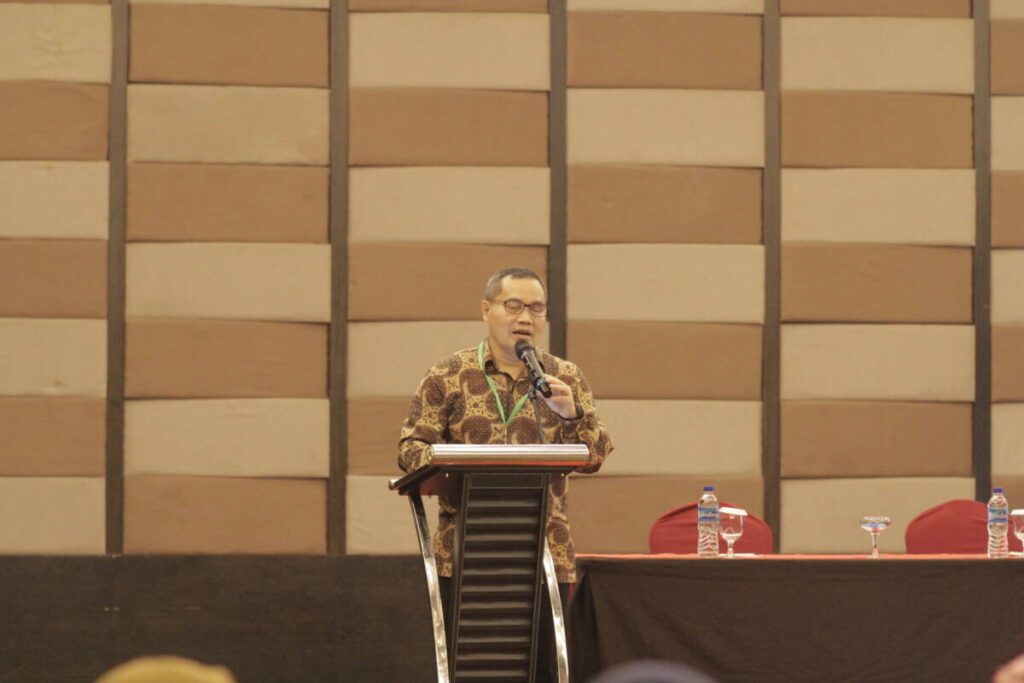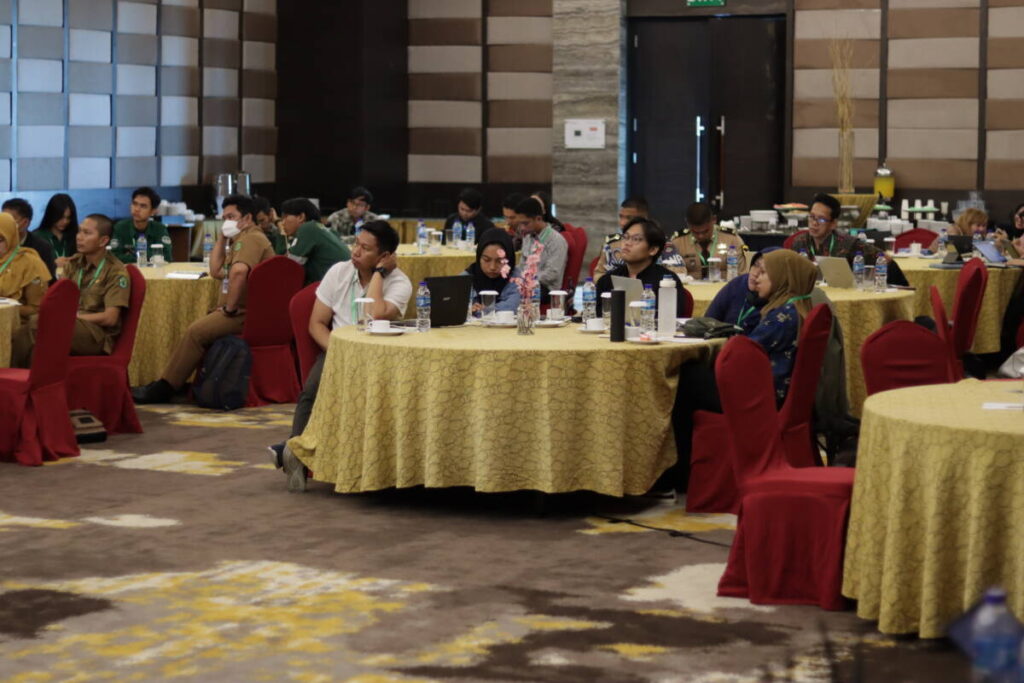Balikpapan, September 5, 2023 – The Institute for Essential Services Reform (IESR) is collaborating with the Clean, Affordable and Secure Energy in Southeast Asia (CASE) program and the Office of Energy and Mineral Resources (ESDM) of East Kalimantan Province to organize a series of East Kalimantan Energy Exploration events—the first workshop of this series held on Tuesday, September 5, 2023.
Director of Electricity, Telecommunications and Information Technology, Ministry of National Development Planning/Bappenas, Rachmat Mardiana, explained that renewable energy development could serve as a new economic driver in the Kalimantan region through the green and blue economy. This can be achieved by utilizing biodiesel, solar power, and other alternative energy sources already spread throughout the province. According to Rachmat, regional governments can support through the General Regional Energy Plan (RUED) under regional authority in developing renewable energy as stated in Law 23/2014 concerning regional governments.
“There are several regional issues in Kalimantan that need to be addressed. These issues include the dominance of fossil energy in electricity production, with only a small amount of renewable electricity generation. In addition, the development of the Indonesian capital city (IKN) requires the provision of renewable electricity. The electricity infrastructure in the region also needs attention as the Kalimantan interconnection system is not yet fully connected, and the extra high voltage transmission has not been connected to evacuate power generated throughout the region,” said Rachmat at the opening of the East Kalimantan Energy Exploration series.
To overcome this regional issue, continued Rachmat, implementing various policy measures that include creating small-scale, isolated grids (referred to as isolated mini-grids), providing eco-friendly and intelligent IKN electricity, developing smart electricity networks, and integrating electricity supplies with industries through the use of primary energy sources, encouraging the use of renewable energy, and developing interconnections between regions.

A workshop session on the energy transition followed the event. Irwan Sarifuddin, the Coordinator of the Clean Energy Hub at IESR, mentioned the importance of a just energy transition. According to Irwan, regional governments need to consider the well-being of workers in coal-fired power plants (CFPPs) and those in supporting areas to transition successfully.
“We must make preparations to ensure that people are not left behind during the transition to energy. In 2022, IESR conducted a study called “Redefining Future Jobs,” which revealed that the profits gained by coal-producing regions are not proportional to the losses experienced by the local population. For example, losses from land degradation and health risks,” explained Irwan.
Agreeing with Irwan, the Energy Transition Advisor from Deutsche Gesellschaft für Internationale Zusammenarbeit (GIZ) Indonesia, Yudiandra Yuwono, emphasized that in carrying out the energy transition, it is necessary to ensure the welfare of society. However, the energy transition process has many elements with various systemic constituencies.
“Some of the challenges of the energy transition include technological readiness, policy support, and acceptance by society itself. For this reason, all stakeholders play an important role in the energy transition,” said Yudiandra.
Furthermore, the workshop related to co-firing and biogas from representatives of IESR and the Office of Energy and Mineral Resources (ESDM) of East Kalimantan Province has been held. Rahmat Jaya Eka Saputra, The Energy Transformation Staff of IESR, said PLN implemented co-firing technology at 36 CFPP locations out of a target of 35 locations during 2022. The PLN co-firing program produced 575.4 GWh of clean energy and reduced carbon emissions by 570 thousand tons of CO2 by utilizing 542 thousand tons of biomass.
“There are several advantages to using biomass as a co-firing fuel. Emissions can be significantly reduced by replacing a proportion of coal with biomass (usually between 20% and 50%). Additionally, carbon dioxide balancing can be achieved by planting new trees that absorb the carbon dioxide produced by the co-firing process. However, it is important to note that co-firing is considered a “transitional” fuel and cannot be relied upon as a long-term solution for meeting our energy needs,” explained Rahmat.
Sonny Widyagara Nadar, Young Expert Policy Analyst for the Office of Energy and Mineral Resources (ESDM) of East Kalimantan Province, stated that the potential for biomass in East Kalimantan is around 936.14 MW and biogas is 150 MW. Thus, in total, the bioenergy potential is around 1,086.14 MW. With this potential, several uses of biomass and biogas have been carried out—for example, rice husks as fertilizer or biomass. There is also the use of biogas from livestock manure.
“There are several challenges in utilizing biogas from livestock manure, namely reaching the farthest areas that experience a shortage of LPG, increasing the scale of biogas for communal livestock, and downstream the use of biogas for community economic use,” explained Sonny.

In the next session, Fadhil Ahmad Qamar, CASE Program Staff of IESR, said that It is possible to transform palm oil mill effluent (POME) into electrical energy, which can be used as an alternative energy source. Fadhil estimates that 14 million hectares of land can produce 146 million tons of POME annually, which can then be processed into 35 million tons of crude palm oil (CPO) and 28.7 million tons of liquid waste. POME is typically treated in open ponds, undergoing anaerobic digestion and generating biogas.
“Using biogas from POME can significantly reduce greenhouse gas (GHG) emissions, such as 26 million tonnes of CO2eq/year if 100 factories utilize it. However, financial and policy support is necessary to create a favorable investment climate to promote biogas from POME,” said Fadhil.
The first day of the East Kalimantan Energy Exploration activities ended with a workshop on preparing articles for the energy transition. During the workshop, Kurniawati Hasjanah, Communications Staff of IESR, highlighted the importance of using critical terms such as energy mix, carbon, and alternative energy in reporting on the energy transition. The coverage of the energy transition mainly focuses on reducing the carbon footprint in energy consumption and promoting the use of alternative energy. Journalists and citizen journalists can benefit from understanding these concepts to provide accurate and informative coverage.
“When journalists cover the energy transition, they usually begin by creating a frame of reference for their reporting. This involves determining the topic, angle, sources, and reference documents to be used, such as the NDC document, Electricity Supply Business Plan (RUPTL) 2021-2030, and Presidential Decree 112/2022. Additionally, a list of videos and photos may be necessary to guide photographers in capturing the necessary coverage,” said Kurniawati Hasjanah.

